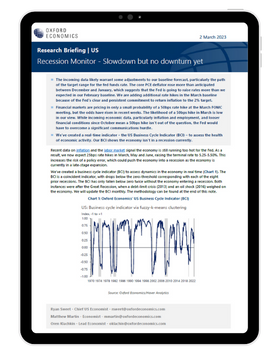US Recession Monitor – Slowdown but no downturn yet

The incoming data likely warrant some adjustments to our baseline forecast, particularly the path of the target range for the fed funds rate. The core PCE deflator rose more than anticipated between December and January, which suggests that the Fed is going to raise rates more than we expected in our February baseline. We are adding additional rate hikes in the March baseline because of the Fed’s clear and persistent commitment to return inflation to the 2% target.
What you will learn:
- Financial markets are pricing in only a small probability of a 50bps rate hike at the March FOMC meeting, but the odds have risen in recent weeks. The likelihood of a 50bps hike in March is low in our view. While incoming economic data, particularly inflation and employment, and looser financial conditions since October mean a 50bps hike isn’t out of the question, the Fed would have to overcome a significant communications hurdle.
- We’ve created a real-time indicator – the US Business Cycle Indicator (BCI) – to assess the health of economic activity. Our BCI shows the economy isn’t in a recession currently.
- The latest BCI reading of 0.37 for January (up from 0.33 in December) signals the economy isn’t in a recession, though it has passed a turning point. We expect recession to coincide with a reading in the range of -0.25 to -0.50. The BCI partly underpins our decision to push back the start of the recession to Q3 2023 in our upcoming March baseline.
Tags:
Related Resources

Post
US economic outlook 2026: Four key calls for the year
US exceptionalism will continue in 2026—but so will the vulnerabilities beneath the surface.
Find Out More
Post
US Shipping freight rates on track to stay low in 2026
Our supply chain stress index moderated in September as import volumes continue to decline following front loading activity earlier this year. High frequency data shows that this trend has kept up in Q4, meaning port congestion is unlikely to become a concern.
Find Out More
Post
Housing affordability remains strained across US metros
A household needed to earn an annual income of $110,100 to afford a single-family home and pay both property taxes and home insurance costs in Q3 2025, down 2.3% from the peak Q1 2025 ($112,700) but nearly twice that of Q3 2020.
Find Out More